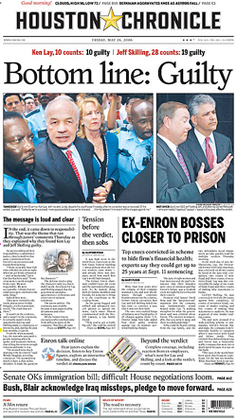
The Houston Chronicle is the largest daily newspaper in Houston, Texas, United States. As of April 2016, it is the third-largest newspaper by Sunday circulation in the United States, behind only The New York Times and the Los Angeles Times. With its 1995 buy-out of long-time rival the Houston Post, the Chronicle became Houston's newspaper of record.
The Georgia Straight is a free Canadian weekly news and entertainment newspaper published in Vancouver, British Columbia, by Overstory Media Group. Often known simply as The Straight, it is delivered to newsboxes, post-secondary schools, public libraries and a large variety of other locations.
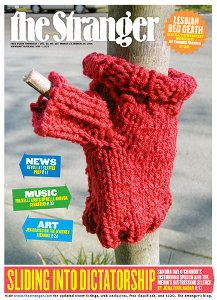
The Stranger is an alternative biweekly newspaper in Seattle, Washington, U.S. The paper's principal competitor is The Seattle Weekly, owned by Sound Publishing, Inc. It has a progressive orientation.
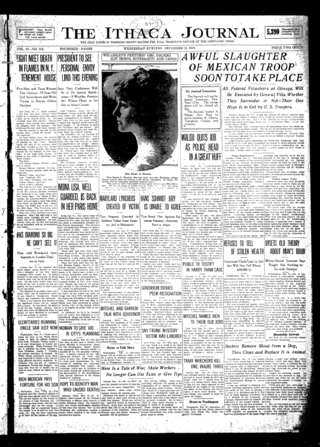
The Ithaca Journal is a daily morning broadsheet newspaper published in Ithaca, New York. It is locally edited and printed in Johnson City, New York, and publishes Monday through Saturday. It has been owned by Gannett since 1912.

The Houston Press is an online newspaper published in Houston, Texas, United States. It is headquartered in the Midtown area. It was also a weekly print newspaper until November 2017.
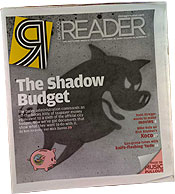
The Chicago Reader, or Reader, is an American alternative newspaper in Chicago, Illinois, noted for its literary style of journalism and coverage of the arts, particularly film and theater. The Reader has been recognized as a pioneer among alternative weeklies for both its creative nonfiction and its commercial scheme. Richard Karpel, then-executive director of the Association of Alternative Newsweeklies, wrote:
[T]he most significant historical event in the creation of the modern alt-weekly occurred in Chicago in 1971, when the Chicago Reader pioneered the practice of free circulation, a cornerstone of today's alternative papers. The Reader also developed a new kind of journalism, ignoring the news and focusing on everyday life and ordinary people.

The Detroit Metro Times is a progressive alternative weekly located in Detroit, Michigan. It is the largest circulating weekly newspaper in the metro Detroit area.
An alternative newspaper is a type of newspaper that eschews comprehensive coverage of general news in favor of stylized reporting, opinionated reviews and columns, investigations into edgy topics and magazine-style feature stories highlighting local people and culture. Its news coverage is more locally focused, and their target audiences are younger than those of daily newspapers. Typically, alternative newspapers are published in tabloid format and printed on newsprint. Other names for such publications include alternative weekly, alternative newsweekly, and alt weekly, as the majority circulate on a weekly schedule.
The News & Review is a group of free alternative weekly newspapers published by Chico Community Publishing, Inc. of Chico, California. The company publishes the Chico News & Review in Chico, California, the Sacramento News & Review in Sacramento, California, and, through Jan. 30, 2022, the Reno News & Review in Reno, Nevada. On January 31, 2022, the Reno News & Review was sold to Coachella Valley Independent LLC.

Creative Loafing is an Atlanta-based publisher of a monthly arts and culture newspaper/magazine. The company publishes a 60,000 circulation monthly publication which is distributed to in-town locations and neighborhoods on the first Thursday of each month. The company has historically been a part of the alternative weekly newspapers association in the United States.
Village Voice Media or VVM is a newspaper company. It began in 1970 as a weekly alternative newspaper in Phoenix, Arizona. The company, founded by Michael Lacey (editor) and Jim Larkin (publisher), was then known as New Times Inc. (NTI) and the publication was named New Times. The company was later renamed New Times Media.
The Pittsburgh City Paper is Pittsburgh's leading alternative weekly newspaper which focuses on local news, opinion, and arts and entertainment. It bought out In Pittsburgh Weekly in 2001. As of April 2015, City Paper is the 14th largest alternative weekly in the United States.

Indy Week, formerly known as the Independent Weekly and originally the North Carolina Independent, is a tabloid-format alternative weekly newspaper published in Durham, North Carolina, United States, and distributed throughout the Research Triangle area and counties. Its first issue was published in April 1983.

The Gazette, also known as the Montreal Gazette, is a Canadian English-language broadsheet daily newspaper which is owned by Postmedia Network. It is published in Montreal, Quebec, Canada.

Boulder Weekly is an alternative newsweekly that publishes every Thursday in Boulder, Colorado. The paper is a member of the Association of Alternative Newsweeklies (AAN) and is owned and published by Stewart Sallo.
The Post Amerikan was an alternative newspaper based in Bloomington-Normal, Illinois. The paper was founded in 1972.

The Santa Fe Reporter (SFR) is an alternative weekly newspaper published in Santa Fe, New Mexico, United States. First published in 1974, it features reports on local news, politics, art and culture, and is published once a week on Wednesdays.
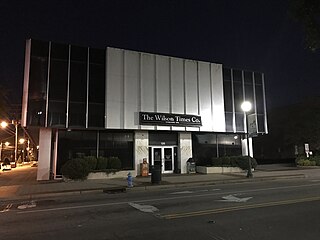
The Wilson Times is an American, English language semiweekly newspaper based in Wilson, North Carolina covering Wilson County. The newspaper is owned by Wilson Times Co. The paper began as Zion's Landmark, established in 1867 by the pastor of the Wilson Primitive Baptist Church, Elder P.D. Gold. In 1896 that pastor founded The Wilson Times, a weekly newspaper. In 1902 the paper began daily publication as The Wilson Daily Times. The newspaper previously offered commercial job print services, book and catalog printing, as well as ruling and bonding services. It also prints the Wilson County Phone Directory, Money Mailer, and Xpress Marketing publications. While initially occupying only a small brick corner store, the Wilson Times upgraded and moved to a custom-built, 30,000-square-foot office building in 1983. The Wilson Times joined the internet in 1997 under the domain wilsondaily.com. The newspaper relocated to its current downtown Wilson office in June 2017. In February 2021, the Times celebrated its 125th anniversary of continuous publication. The first edition of The Wilson Times was printed in February 1896.

A newspaper is a periodical publication containing written information about current events and is often typed in black ink with a white or gray background. Newspapers can cover a wide variety of fields such as politics, business, sports, art, and science. They often include materials such as opinion columns, weather forecasts, reviews of local services, obituaries, birth notices, crosswords, editorial cartoons, comic strips, and advice columns.
Las Vegas CityLife, founded in August 1996, was the oldest alternative weekly newspaper in Southern Nevada and covered news about the Las Vegas Valley and surrounding areas. Coverage included news, politics, arts, and culture reporting in print and online formats.















